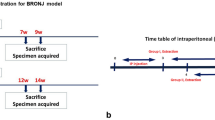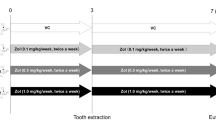Abstract
Bisphosphonates (BPs) are clinically used for the treatment of bone metabolic abnormalities because they are powerful inhibitors of bone resorption. Osteonecrosis of the jaw has been observed after tooth extraction in a considerable number of BP-treated cancer patients, but the reason for this is not known. We studied the effects of BP on extraction socket healing in rats that were pretreated with BP prior to tooth extraction. Male Wistar rats (approximately 5 weeks old) were divided into experimental (BP) and control groups. In both groups, maxillary right second molars were extracted under general anesthesia. BP group rats were injected with 50 μl (1.0 mg/kg) alendronate into the right buccal alveolar bone every 4 days for 14 days, starting 2 days before tooth extraction. Control group rats were injected with physiological saline instead of alendronate. Rats were euthanized 3, 7, 10 or 14 days after tooth extraction, and maxillary bones were collected. Bone morphometric analysis using microfocus X-ray CT images and calculation of bone-resorption parameters based on hematoxylin and eosin or TRAP-stained pathological sections of the molar region showed that new bone formation in the extraction socket was delayed in the BP group relative to the control group during the first 7 days after extraction. A subsequent increase in new bone formation showed that bone resorption in the BP rats was eventually inhibited. This delay in initial healing may explain the jaw osteonecrosis observed in some BP-treated cancer patients.









Similar content being viewed by others
References
Reitsma PH, Bijvoet OLM, Verlinden-Ooms H, van der Wee-pals LJA (1980) Kinetic studies of bone and mineral metabolism during treatment with (3-amino-1-hydroxypropylidene)-1,1-bisphosphonate (APD) in rat. Calcif Tissue Int 32:145–157
Ammann P, Rizzoli R, Caverzasio J, Shigematsu T, Slosman D, Bonjour JP (1993) Effects of the bisphosphonate tiludronate on bone resorption, calcium balance, and bone mineral density. J Bone Miner Res 8:1491–1498
Ryan PJ, Sherry M, Gibron T, Fogelmen I (1992) Treatment of Paget’s disease by weekly infusions of 3-aminohydroxypropylidene-1,1-bisphosphonate (APD). Br J Rheumatol 31:97–101
Glover D, Lipton A, Miller AA, Browning S, Fram RJ, George S, Zelenakas K, Mecerata RS, Seaman JJ (1994) Intravenous pamidronate disodium treatment of bone metastases in patients with breast cancer. A dose-seeking study. Cancer 74:2949–2955
Kohono N (2008) Treatment of breast cancer with bone metastasis: bisphosphonate treatment—current and future. Int J Clin Oncol 13:18–23
Marx RE (2003) Pamidornate(Aredia) and zoledronate(Zometa) induced avascular necrosis of the jaws: a growing epidemic. J Oral Maxillofac Surg 61:1115–1117
Naito T (2005) Cell dynamics during osseous healing of tooth extraction sockets in mice. J Jpn Stomatol Soc 54:1–11
Altundal H, Guvener O (2003) The effect off alendronate on resorption of the alveolar bone following tooth extraction. Int J Oral Maxillofac Surg 33:286–293
Cole AA, Wezeman FH (1987) Cytochemical localization of tartrate-resistant acid phosphatase, alkaline phosphatase, and nonspecific esterase in perivascular cells of cartilage canals in the developing mouse epiphysis. Am J Anat 180:237–242
Cole AA, Wezeman LM (1987) Tartrate-resistant acid phosphatase in bone and cartilage following decalcification and cold-embedding in plastic. J Histochem Cytochem 35:203–206
Fleisch H, Russell RGG, Bisaz S, Muhlbauer RC, Williams DA (1970) The inhibitory effect of phosphonates on the formation of calcium phosphate crystals in vivo. Eur J Clin Invest 1:12–18
Russell RGG, Muhlbauer RC, Williams DA, Fleisch H (1970) The influence of pyrophosphate, condensed phosphates, phosphonates, and on bone resorption induced by parathyroid hormone in tissue culture and in thyroparathyroidectomised rats. Calcif Tissue Res 6:183–196
Azuma Y, Sato H, Oue Y, Okabe K, Ohta T, Tsuchimoto M, Kiyoki M (1995) Alendronate distributed on bone surfaces inhibits osteoclastic bone resorption in vitro and in experimental hypercalcemia models. Bone 16:235–245
Murakami H, Takahashi N, Sasaki T (1995) A possible mechanism of the specific action of bisphosphonates on osteoclasts: Tildronate preferentially affects polarized osteoclasts having ruffled borders. Bone 17:137–144
Sato M, Grasser W, Endo N, Akins R, Simmons H, Thompson DD, Golub E, Rodan GA (1991) Bisphosphonate action. Alendronate localization in rat bone and effects on osteoclast ultrastructure. J Clin Invest 88:2095–2105
Hughes DE, MacDonal BR, Russell RGG (1989) Inhibition of osteoclast-like cell formation by bisphosphonates in long-term cultures of human bone marrow. J Clin Invest 83:1930–1935
Nishikawa M, Akatsu T, Katayama Y, Yasutomo Y, Kado S, Kugai N, Yamamoto M, Nagata N (1996) Bisphosphonates act on osteoblastic cells and inhibit osteoclast formation in mouse marrow cultures. Bone 18:9–14
Fisher JE, Rogers MJ, Halasy JM (1999) Alendronate mechanism of action: geranylgeraniol, an intermediate in the mevalonate pathway, prevents inhibition of osteoclast formation, bone resorption, and kinase activation in vitro. Proc Natl Acad Sci USA 96:133–138
Hughes DE, Wright KR, Uy HL (1995) Bisphosphonates promote apoptosis in murine osteoclasts in vitro and in vivo. J Bone Miner Res 10:1478–1487
Van Beek E, Lowik C, van der Pluijm G (1999) The role of geranylgeranylations in fetal bone explants in vitro: a clue to the mechanism of action of nitrogen-containing bisphosphonates. J Bone Miner Res 14:722–729
Van Beek E, Pieterman E, Cohen L (1999) Nitrogen-containing bisphosphonates inhibit isopentenyl pyrophosphonate synthase activity with relative potencies in vitro and in vivo. Biochem Biophys Res Commun 16:491–494
Harinck HIJ, Bijvoet OLM, Plantingh AST, Body JJ, Elte JWF, Shleeboom HP, Wildiers J, Neijt JP (1987) Role of bone and kidney in tumor-induced hypercalcemia and its treatment with bisphosphonate and sodium chloride. Am J Med 82:1133–1142
Grier RL, Wise GE (1998) Inhibition of tooth eruption in the rat by a bisphosphonate. J Dent Res 77:8–15
Warita H, Kirino Y, Kurihara S, Ohya K (1992) Effects of local injection with bisphosphonate (HEBP) on experimental tooth movement. J Jpn Ortho Soc 51:292–301
Saeki N, Iizuka T, Aita H, Kohgo T, Ohta N (2001) Effect of bisphonate on the healing process of tooth extraction wounds. Hokkaido J Dent Sci 22:185–201
Binderman I, Adut M, Yaffe A (2000) Effectiveness of local delivery of alendronate in reducing alveolar bone loss following periodontal surgery in rats. J Periodontol 71:1236–1240
Bisaz S, Jung A, Fleisch H (1978) Uptake by bone of pyrophosphate, disphosphonates and their technetium derivatives. Clin Sci Mol Med 54:265–272
Franagan AM, Chambers TJ (1989) Dichlorometthylenbisphosphonate (C12MBP) inhibits bone resorption through injury to osteoclasts that resorb C12MBP coated bone. Bone Miner 6:33–43
Pietrokovski J, Massler M (1967) Ridge remodeling after tooth extraction in rats. J Dent Res 46:222–231
Todo H (1968) Healing mechanism of tooth extraction wounds in rats-I. Initial cellular response to tooth extraction in rats studied with 3H-thymidine. Arch Oral Biol 13:1421–1427
Johansen JR (1970) Repair of the post-extraction alveolus in the Wistar rats. A histologic and autoradiographic study. Acta Odontol Scand 28:441–461
Shindoh M (1982) Morphological studies on osteoclastic bone resorption in extraction wound of lathyric rat. Jpn J Oral Biol 24:668–705
Hirosawa H (1996) Effect of inhibitor of bone resorption on wound healing after tooth extraction. Ou Univ Dent J 23:170–181
Iizuka T, Miller SC, Marks SC Jr (1992) Alveolar bone remodeling after tooth extraction in normal and osteopetrotic (ia) rats. J Oral Pathol Med 21:150–155
Yamamoto Y, Udagawa N, Matsuura S, Nakamichi Y, Horiuchi H, Hosoya A, Nkamura M, Ozawa H, Takaoka K, Penninger JM, Noguchi T, Takahashi N (2006) Osteoblasts provide a suitable microenvironment for the action of receptor activator of nuclear factor-kB Ligand. Endocrinology 147:3366–3374
Tabuchi M, Miyazawa K, Kimura M, Maeda H, Kawai T, Kameyama Y, Goto S (2005) Enhancement of crude morphogenetic protein-induced new bone formation and normalization of endochondral ossification by bisphosphonate treatment in osteoprotegerin-deficient mice. Calcif Tissue Int 77:239–249
AAOMS Position Paper (2007) American association of oral and maxillofacial surgeons position paper on bisphosphonate-related osteonecrosis of the jaws. J Oral Maxillofac Surg 65:369–376
Stephen TS, Brynmor AW, Gregory DL, Mark AL, Kenneth CA (2009) Bony changes in the jaws of rats treated with zoledronic acid and dexamethasone before dental extraction mimic bisphosphonate-related osteonecrosis in cancer patients. Oral Oncol 45:164–172
Acknowledgments
This study was partially supported by a Grant-in-Aid for Scientific Research from the Ministry of Education, Science and Culture of Japan (19592378).
Author information
Authors and Affiliations
Corresponding author
About this article
Cite this article
Hikita, H., Miyazawa, K., Tabuchi, M. et al. Bisphosphonate administration prior to tooth extraction delays initial healing of the extraction socket in rats. J Bone Miner Metab 27, 663–672 (2009). https://doi.org/10.1007/s00774-009-0090-6
Received:
Accepted:
Published:
Issue Date:
DOI: https://doi.org/10.1007/s00774-009-0090-6




